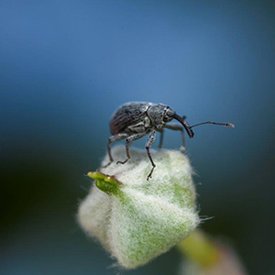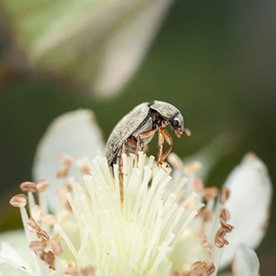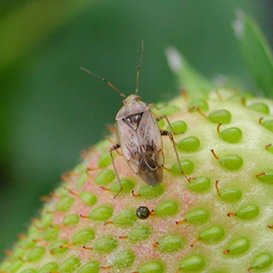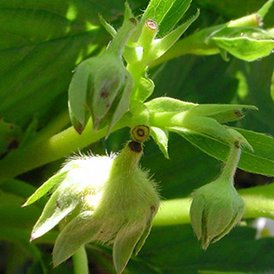Better traps for pest insects in organic berries
During the past three years, researchers in Norway, Denmark, Sweden, the UK, Switzerland and Latvia joined forces to make control measures against pest insects more efficient.

The pest insect strawberry blossom weevil (Anthonomus rubi), European tarnished plant bug (Lygus rugulipennis) and raspberry beetle (Byturus tomentosus) can cause large losses in yield and quality in organically grown raspberries and strawberries.
In the following interview, Atle Wibe gives an overview of Softpest Multitrap's achievements.
Mr Wibe, what control measures against the major pest insects strawberry blossom weevil and the raspberry beetle do organic strawberry and raspberry growers have at present?
There are few specific measures against these pest insects. However, agronomists know that when establishing new fields they have to think about how far they are to nearby berry fields and the surrounding vegetation to avoid invasions of pest insects.
Growing berries in the same area over time may increase the density of these insects, thus good crop rotation reduces insect damage. Some have been using white sticky traps but these traps seem to be less effective. Others are using active substances such as Spinosad that kills insects.
Spinosad is very efficient against major pest insects in organic berries,
why does it need additional research?
Using Spinosad is a “conventional” approach and essentially means just exchanging a conventional input with an organic input. We are searching for measures that target the pest insect species without having a negative impact on the beneficial species. With the use of chemical measures, even if of natural origin, pollinators and predators will also be killed. If we find approaches that do not impair biodiversity, we can continue to benefit from the ecosystem services provided by these insect species. I would say that our approach matches the organic principles better. Be this as it may, existing measures are often not efficient enough and professional organic berry growers have to take quite a high risk in terms of yield losses.
How important can these losses be?
The losses vary between years and from region to region. From some strawberry fields in Norway it has been reported that about 80% of the flower buds were damaged by the strawberry blossom weevil. In raspberries, too, major losses because of pest insects often occur. In addition to reduced yields, decreased product quality is common. This can take the form of misshaped berries or insect larvae within the berries. Thus it is clear that losses are significant. The major challenges regarding pest insects, though, differ between regions or countries.
What were your goals in the Softpest Multitrap project?
Our main goal was to develop traps and lures to attract and kill the pest insects more efficiently without interfering with the natural biodiversity. To create a measure that is as practical as possible, we aimed to make one trap targeting different pest insect species. Partners in Sweden and the UK analysed host plant volatiles and pheromones to make efficient attractive baits that could lure insects to the traps. We also searched for natural repellents to avoid pest insect invasions.
To optimise the design of traps, partners in the UK led activities to reveal what is the most effective trap in different type of crops, and tested these in Switzerland and Norway. Field studies of e.g. optimal density and spatial and temporal patterns of trap deployment in strawberries were led by the Norwegian partner in collaboration with partners from Denmark and Latvia. Such studies in raspberries were led by Switzerland in collaboration with the Norwegian partner. You see, all partners were integrated in almost all activities.
What are the main achievements of the project?
Our main conclusion is that mass trapping pest insects in both strawberries and raspberries by using traps baited with plant volatiles and insect pheromones reduces damage and provides more marketable fruits. Traps targeting specific pest insects seem to have no negative impact on other insect species. This is important for conserving biodiversity and being able to use the ecosystem services provided by other insect species.


The strawberry blossom weevil The raspberry beetle
Can you tell us more about the experiments with volatiles?
Without volatiles, the traps would not attract the pest insects. The colour of the traps has some impact on the attraction of these insect species but without volatiles, the traps would be ineffective. The insects produce pheromones for communication between individuals of the same species. For some species, the attraction to traps baited with such pheromones is very strong. For other species the attraction to synthetically produced pheromones is moderate. However, these pheromones may synergize with host plant volatiles, attracting more than the sum of each treatment.
In our studies, we have been using pheromones mixed with volatiles from wild strawberry flowers and raspberry plants and have shown that such mixtures are important for making efficient traps. We think that this use of mixtures of different types of volatiles is a breakthrough in the search for effective attractants. Now we are able to attract more pest insects to traps without impairing other species.
What other findings did you make?
One interesting finding is that putting traps in the perimeter of a field may reduce the migration of pest insects into that field. However, these traps will not affect individuals overwintering in the field and their offspring. On the other hand, when establishing a new field this can be of significant help. If you are able to slow down or postpone the establishment of a pest insect population in a field, the total damage caused by this insect can be reduced.
Another important finding is that it is possible to attract different pest species to the same trap at the same time. It is not unusual that several pest species are in the same field. Thus, for the farmer it will be more practical to use a “multitrap” to catch pest insects of different species.
So is the problem for organic berry growers now solved?
We have been testing our findings on-farm and we have identified several points still to be improved. Although we caught significant numbers of pest insects by these traps, we wish that the traps could be even more efficient. We observed that several insects were attracted to the traps but were able to escape. Our results can be important indeed for soft berry producers but the findings have to be adapted to local conditions and implemented in practical production. So no, we cannot yet come with a final solution. It needs to be taken into consideration that Softpest Multitrap was one of the first approaches to manage non-lepidopteran insect pests of horticultural crops using semiochemicals in the EU, and probably the first to target multiple species from different insect orders.
Thanks to this ERA-net project we were able to set up a consortium including the most experienced experts in that field. So, we hope to be able to continue our cooperation within new projects and come to practicable solutions within a few years.
Last question:
To what extent does the increasing problem with Drosophila suzukii influence your research activities?
The problems with Drosophila suzukii greatly influence the work of our partner in Switzerland. The damage caused by theses flies is very extensive and there are few measures available. We up here in the north are waiting to see what happens. This Asian species has already been seen in Sweden and we expect that it will also migrate to Norway. Hopefully, it will find it too cold and stay away. But with this climate change we are into, we have to be prepared for all kind of changes.


The European tarnished plant bug Damaged by the strawberry blossom beetle
Go to Softpest Multitrap's image gallery
More information about Softpest Multitrap:
Go to articles about the project:
"Using semiochemical traps to study the occurrence of strawberry blossom weevil in strawberry and raspberry – what did we learn?"
"The potential for mass trapping Lygus rugulipennis and Anthonomus rubi; trap design and efficacy"
"Mass trapping Anthonomus rubi and Lygus rugulipennis in strawberries"
All publications from Softpest Multitrap are available on Organic Eprints
Contact:
Atle Wibe,
(+47) 404 80 087
atle.wibe@nibio.no